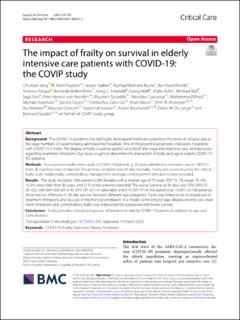The impact of frailty on survival in elderly intensive care patients with COVID-19: the COVIP study
| dc.contributor.author | Jung, Christian | |
| dc.contributor.author | Flaatten, Hans | |
| dc.contributor.author | Fjølner, Jesper | |
| dc.contributor.author | Romano Bruno, Raphael | |
| dc.contributor.author | Wernly, Bernhard | |
| dc.contributor.author | Artigas, Antonio | |
| dc.contributor.author | Pinto, Bernardo Bollen | |
| dc.contributor.author | Schefold, Joerg C. | |
| dc.contributor.author | Wolff, Georg | |
| dc.contributor.author | Kelm, Malte | |
| dc.contributor.author | Beil, Michael | |
| dc.contributor.author | Sviri, Sigal | |
| dc.contributor.author | van Heerden, Peter Vernon | |
| dc.contributor.author | Szczeklik, Wojciech | |
| dc.contributor.author | Czuczwar, Miroslaw | |
| dc.contributor.author | Elhadi, Muhammed | |
| dc.contributor.author | Joannidis, Michael | |
| dc.contributor.author | Oeyen, Sandra | |
| dc.contributor.author | Zafeiridis, Tilemachos | |
| dc.contributor.author | Marsh, Brian | |
| dc.contributor.author | Andersen, Finn Husøy | |
| dc.contributor.author | Moreno, Rui | |
| dc.contributor.author | Cecconi, Maurizio | |
| dc.contributor.author | Leaver, Susannah | |
| dc.contributor.author | Boumendil, Ariane | |
| dc.contributor.author | De Lange, Dylan W. | |
| dc.contributor.author | Guidet, Bertrand | |
| dc.date.accessioned | 2021-11-23T12:13:08Z | |
| dc.date.available | 2021-11-23T12:13:08Z | |
| dc.date.created | 2021-05-05T14:28:47Z | |
| dc.date.issued | 2021 | |
| dc.identifier.issn | 1364-8535 | |
| dc.identifier.uri | https://hdl.handle.net/11250/2830995 | |
| dc.description.abstract | Background The COVID-19 pandemic has led highly developed healthcare systems to the brink of collapse due to the large numbers of patients being admitted into hospitals. One of the potential prognostic indicators in patients with COVID-19 is frailty. The degree of frailty could be used to assist both the triage into intensive care, and decisions regarding treatment limitations. Our study sought to determine the interaction of frailty and age in elderly COVID-19 ICU patients. Methods A prospective multicentre study of COVID-19 patients ≥ 70 years admitted to intensive care in 138 ICUs from 28 countries was conducted. The primary endpoint was 30-day mortality. Frailty was assessed using the clinical frailty scale. Additionally, comorbidities, management strategies and treatment limitations were recorded. Results The study included 1346 patients (28% female) with a median age of 75 years (IQR 72–78, range 70–96), 16.3% were older than 80 years, and 21% of the patients were frail. The overall survival at 30 days was 59% (95% CI 56–62), with 66% (63–69) in fit, 53% (47–61) in vulnerable and 41% (35–47) in frail patients (p < 0.001). In frail patients, there was no difference in 30-day survival between different age categories. Frailty was linked to an increased use of treatment limitations and less use of mechanical ventilation. In a model controlling for age, disease severity, sex, treatment limitations and comorbidities, frailty was independently associated with lower survival. Conclusion Frailty provides relevant prognostic information in elderly COVID-19 patients in addition to age and comorbidities. | en_US |
| dc.language.iso | eng | en_US |
| dc.publisher | BMC | en_US |
| dc.rights | Navngivelse 4.0 Internasjonal | * |
| dc.rights.uri | http://creativecommons.org/licenses/by/4.0/deed.no | * |
| dc.title | The impact of frailty on survival in elderly intensive care patients with COVID-19: the COVIP study | en_US |
| dc.type | Peer reviewed | en_US |
| dc.type | Journal article | en_US |
| dc.description.version | publishedVersion | en_US |
| dc.source.volume | 25 | en_US |
| dc.source.journal | Critical Care | en_US |
| dc.identifier.doi | 10.1186/s13054-021-03551-3 | |
| dc.identifier.cristin | 1908239 | |
| cristin.ispublished | true | |
| cristin.fulltext | original | |
| cristin.qualitycode | 2 |

